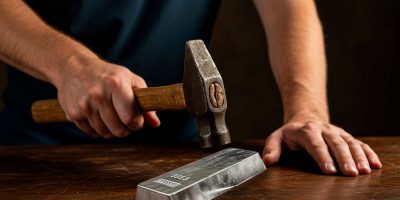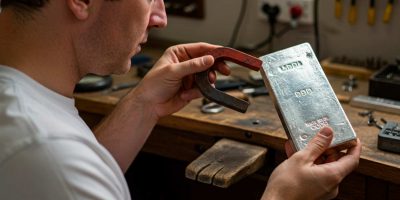Silver is one of the most versatile and valued precious metals, prized for its beauty and practicality. Its unique density—how much mass fits into a given space—sets it apart. This property influences silver’s use in coins, jewelry, and industry, making it critical to understanding its value and authenticity.
Whether you’re investing in silver or exploring its many applications, knowing about its density provides a practical foundation for smarter decisions.
| Key Takeaways |
|---|
| The density of silver plays a role in its value, authenticity, and widespread use in coins, jewelry, and industry, making it indispensable in the world of precious metals. |
| Silver coins, like the American Silver Eagle and the British Silver Britannia, combine artistry and reliability, offering a tangible way to store wealth. |
| Silver bars, available in sizes ranging from compact options to massive 1,000-kilogram bars, provide flexible investment opportunities tailored to diverse needs. |
| Measuring silver density is a practical way to confirm authenticity, helping investors and collectors avoid counterfeit products. |
| OWNx offers innovative fractional ownership options, allowing investors to own portions of large silver bars without the hassle of physical storage. |
Understanding the Density of Silver
Density might sound technical, but it’s really straightforward. Think of it as how much “stuff” fits into a certain amount of space. For silver, this translates to 10.49 grams packed into every cubic centimeter. This means a one-centimeter cube of silver weighs just over 10 grams.
Compared to other metals, silver has a moderate density that sets it apart. Gold, for example, is nearly twice as dense at 19.32 grams per cubic centimeter, which is why a gold coin of the same weight as a silver coin is much smaller. On the other hand, lighter metals like aluminum, with a density of 2.7 grams per cubic centimeter, feel far less substantial.
Silver’s balance of weight and workability makes it ideal for both intricate designs and practical applications. Its density is also a key factor in verifying its authenticity, making it indispensable in coins, bars, and other investment-grade products.
Silver Coins: Weight, Purity, and Value
The density of silver is key to ensuring the precision and reliability of silver coins. It dictates their weight and size, allowing coins to meet exact standards that make them both practical for trade and valuable as investments. This consistency helps distinguish genuine coins from counterfeits, as any deviations in weight or dimensions can indicate impurities or substitutes for pure silver.
Many well-known silver coins, such as the American Silver Eagle and Canadian Maple Leaf, are legal tender in their home countries, though the face value of these coins—like one US dollar for the American Silver Eagle or five Canadian dollars for the Maple Leaf—is often significantly lower than the actual market value of the silver they contain. This reinforces their primary use as investment assets rather than day-to-day currency.
For investors, silver coins offer a tangible and easily tradable way to hold wealth. Their universal recognition and standardized specifications make them appealing for diversifying portfolios. Collectors, on the other hand, value these coins for their historical and artistic significance, with designs that often highlight national heritage, cultural icons, or commemorative events.
Famous Mints and Silver Production
The world’s mints play a crucial role in maintaining the quality and value of silver bars and coins. Renowned institutions such as the United States Mint, Royal Canadian Mint, and Perth Mint in Australia are celebrated for their reliability and craftsmanship.
- The American Silver Eagle is recognized worldwide for its iconic design and 99.9% purity, making it a cornerstone of many silver portfolios.
- The Canadian Maple Leaf, produced by the Royal Canadian Mint, is known for its advanced security features, such as laser-engraved details that deter counterfeiting.
- The British Silver Britannia, minted by The Royal Mint in the United Kingdom, combines intricate design with advanced security measures, showcasing the strength and heritage of British silver coinage.
Silver is mined from the earth, often as a byproduct of extracting other metals like copper or zinc. After refining, it is shaped into coins and bars. Silver bars are available in a variety of sizes, from compact investment-grade options to massive 1,000-kilogram bars used by institutions and large-scale investors. These larger bars offer a cost-efficient way to hold significant quantities of silver, making them a key part of the global silver market.
Whether you’re drawn to the artistry of coins or the practicality of bars, these products from trusted mints provide tangible value, enduring reliability, and opportunities to diversify and grow your portfolio.
Pure Silver vs. Alloys
Pure silver, also known as fine silver, is 99.9 percent pure. This high purity gives it a density of 10.49 grams per cubic centimeter, making it ideal for investments like coins, bars, and bullion. However, pure silver is relatively soft, which limits its practicality in everyday applications.
To make silver more durable, it’s often alloyed with other metals like copper. Sterling silver, for example, contains 92.5 percent silver and 7.5 percent copper. This blend changes the density slightly but significantly increases the material’s strength, making it suitable for items like jewelry and utensils that need to withstand regular wear and tear.
Coin silver, historically used in U.S. currency, contains 90 percent silver and 10 percent other metals. While this composition reduces the silver content slightly, it makes the coins more robust and resistant to damage, ensuring they last longer in circulation.
Understanding the difference between pure silver and alloys helps investors and collectors make informed choices. Whether you’re seeking investment-grade bullion or practical items like sterling silver jewelry, density provides valuable insights into the material’s composition and durability.
Measuring and Understanding Silver Density
Measuring the density of silver is one of the most effective ways to confirm authenticity. The formula is straightforward: divide an object’s weight by its volume. For example, if a silver bar weighs 500 grams and occupies 47.68 cubic centimeters, its density would be 10.49 grams per cubic centimeter—proof of its purity.
This method is particularly useful for identifying counterfeits. Metals like zinc or tin, often used to mimic silver, have lower densities and will fail this test. With professional tools or even simple measurements, discrepancies in weight or size can raise red flags, helping collectors and investors avoid costly mistakes.
Understanding this property not only ensures confidence in purchases but also highlights silver’s reliability as a tangible asset. Whether you’re buying coins, bars, or jewelry, density is a practical tool for verifying value.
Practical Applications of Silver Density
Silver’s density doesn’t just impact its value; it also shapes its role across industries. Its weight and durability make it a favorite for intricate jewelry designs, ensuring pieces maintain their elegance and form. The same qualities give silver coins their satisfying heft, appealing to both collectors and investors.
In industrial applications, silver’s density pairs with its conductivity to make it indispensable in electronics, solar panels, and medical devices. Its reliability in tiny, precise components like wiring and switches ensures functionality where other metals might fail.
Silver’s density also ensures longevity in renewable energy solutions like solar cells, where it supports consistent performance over time. For investors, this growing demand underscores silver’s value as both an industrial material and a precious metal.
OWNx and Fractional Ownership of Silver
OWNx offers a modern solution for investing in silver, making it more accessible than ever through fractional ownership. Instead of purchasing large bars or multiple coins, you can buy a portion of silver based on your budget. This approach eliminates the need for physical storage and security while still allowing you to invest in a tangible asset.
With fractional ownership, you gain all the benefits of investing in precious metals without the logistical challenges. It’s perfect for those looking to diversify their portfolio without committing to significant upfront costs. OWNx’s innovative system makes silver investment simple, flexible, and scalable, no matter your financial goals.
Conclusion
Silver’s density is far more than a scientific fact—it’s a cornerstone of its value, versatility, and authenticity. From its role in coins and jewelry to its use in electronics and renewable energy, density shapes how silver is used and trusted worldwide.
For collectors, density ensures silver coins and bars have the right weight and feel, adding to their appeal as tangible assets. For investors, density provides a reliable way to verify authenticity and understand the value of silver in their portfolios.
OWNx makes investing in silver easier than ever. With fractional ownership, you can enjoy the benefits of silver investment without the hassle of storage or high upfront costs. Whether you’re new to precious metals or a seasoned investor, OWNx gives you the tools to build your portfolio at your pace.
Take the first step today and explore how OWNx can simplify your silver investment journey.
FAQs
What is the density of silver?
The density of silver is 10.49 grams per cubic centimeter, making it a key factor in its silver mass and its use in coins, bars, and industrial applications.
What is the relative density of silver compared to water?
The relative density of silver is approximately 10.49, meaning it is 10.49 times denser than water, ensuring its stability and consistency for the same volume of material.
Why is a bullion coin a popular choice for investors?
A bullion coin is trusted for its high purity, silver density, and unit volume standardization, ensuring consistent weight and authenticity for investment purposes.
How does the silver atom contribute to its properties?
The silver atom, as listed in the periodic table, supports conductivity and versatility, making silver essential in industrial applications and investments.
What does one troy ounce mean in silver investing?
One troy ounce equals 31.1035 grams and is the globally recognized unit of weight for silver coins and bars, ensuring standardization and reliability.
How does silver density affect a given volume of material?
Silver density ensures that a given volume of coins or bars meets precise weight specifications, providing reliability and value in investment-grade products.






